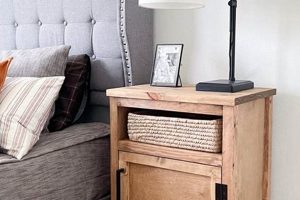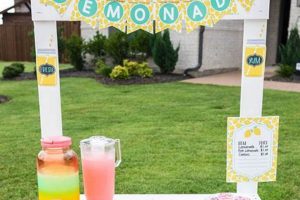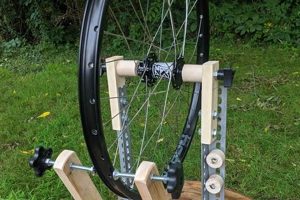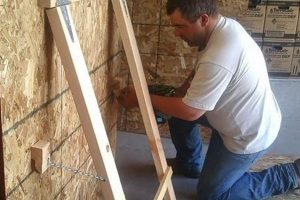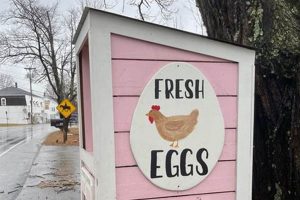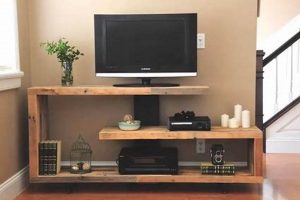A homemade display solution for cake pops involves creating a stand using readily available materials. These stands provide a stable and visually appealing presentation for the confectionery treats, elevating their aesthetic appeal. An example could be crafting a multi-tiered display using foam board and decorative paper, allowing individual cake pops to be easily accessible and showcased.
The construction of a bespoke presentation structure offers several advantages. It allows for cost-effective customization to match a specific event theme or color scheme. Further, the process encourages creative expression and resourcefulness, transforming everyday items into functional and decorative pieces. Historically, homemade display solutions have been a cornerstone of home baking and event presentation, reflecting a dedication to personalization and attention to detail.
The following sections will delve into various design considerations, material choices, and construction techniques applicable to building customized display solutions for confectionery items, ensuring a professional and appealing final product.
Tips for Optimal Homemade Confectionery Displays
Effective design and construction are paramount when creating a custom confectionery display. Adherence to the following tips can improve structural integrity and visual appeal.
Tip 1: Material Selection is Crucial. Opt for materials that are food-safe and sturdy. Avoid porous substances that may harbor bacteria or compromise the presentation’s stability. Examples include using food-grade foam, acrylic, or thoroughly sealed wood.
Tip 2: Prioritize Stability. Ensure the base is wide and weighted appropriately to prevent tipping. Uneven distribution of weight can lead to instability, damaging the treats and the display itself. Testing with progressively more weight is recommended.
Tip 3: Consider Hole Spacing and Size. Accurately measure the diameter of the cake pop sticks to ensure a snug but not overly tight fit. Consistent spacing between holes will contribute to a neater and more professional appearance.
Tip 4: Decorate Thoughtfully. Decorations should complement the cake pops and event theme without overpowering them. Subtlety and cohesive color schemes are typically more effective than elaborate designs. Consider using food-safe paint or adhesive if directly contacting food items.
Tip 5: Account for Transport. If the display needs to be moved, consider incorporating handles or a modular design for easier disassembly and reassembly. A protective carrying case is also recommended to prevent damage during transportation.
Tip 6: Incorporate Height Variation. A multi-tiered design can create visual interest and allow for better visibility of all cake pops. However, ensure the structure remains stable and that the tallest tiers do not obstruct views.
Tip 7: Test Before the Event. Conduct a trial run to identify any potential issues with stability, spacing, or overall appearance. Addressing problems in advance will prevent last-minute complications.
By incorporating these considerations, builders of customized confectionery displays can ensure a structurally sound and visually appealing presentation. A well-executed homemade presentation enhances the overall experience and adds a personalized touch to any event.
The subsequent sections will explore specific design ideas and innovative approaches to elevate the art of displaying homemade confectionery treats further.
1. Structural Integrity
Structural integrity is paramount in the design and construction of a homemade confectionery display. It directly influences the stability and longevity of the structure, ensuring the safe and visually appealing presentation of cake pops.
- Base Stability
The base of the display must provide a solid and balanced foundation. Its dimensions and material composition dictate the load-bearing capacity of the entire structure. A base that is too small or constructed from a weak material will be prone to tipping, potentially damaging the cake pops. For example, a wide, weighted base made from dense foam board or wood provides superior stability compared to a flimsy cardboard foundation.
- Material Strength
The selected materials must possess sufficient strength to withstand the combined weight of the cake pops and the forces exerted during handling and transport. The supporting structure should be resistant to bending, warping, or compression. Failure to account for material strength can result in structural failure, jeopardizing the presentation. For instance, thin skewers or weak adhesives can compromise the integrity of the connection points, leading to instability.
- Joint Reinforcement
The points where different components of the display connect require robust reinforcement to prevent separation or collapse. Adhesives, fasteners, or interlocking designs should be employed to create strong and durable joints. Insufficient joint reinforcement is a common point of failure in homemade confectionery displays. For example, poorly glued joints or inadequately secured supporting structures are vulnerable to stress and can lead to structural compromise.
- Weight Distribution
An even distribution of weight across the structure is critical for maintaining stability. The design should account for the placement of the cake pops and ensure that the load is distributed evenly across the base and supporting elements. Uneven weight distribution can create stress points, increasing the risk of tipping or collapse. For example, placing all of the cake pops on one side of the display or using an asymmetrical design can compromise the structural integrity.
In essence, structural integrity is not merely an aesthetic concern but a functional requirement for the successful implementation of a homemade confectionery display. Careful consideration of base stability, material strength, joint reinforcement, and weight distribution is essential to ensure a safe, stable, and visually appealing presentation.
2. Material Suitability
The viability of a homemade confectionery display hinges on the selection of appropriate construction materials. Material suitability directly affects structural integrity, food safety, and aesthetic presentation. The ramifications of using inappropriate materials range from structural instability and potential food contamination to an unprofessional appearance. For instance, employing non-food-grade plastics could lead to chemical leaching into the confections, while flimsy cardboard might buckle under the weight, causing a collapse of the display.
Appropriate material choices demonstrate a direct influence on the final product’s quality and safety. For example, utilizing food-grade expanded polystyrene (EPS) foam can provide a lightweight yet stable base, assuming it is properly sealed to prevent direct contact with the food. Similarly, using acrylic sheets allows for creating transparent tiers that are both aesthetically pleasing and easy to clean. Conversely, the use of porous materials, such as untreated wood, presents challenges related to hygiene and potential bacterial growth, underscoring the importance of selecting non-porous, food-safe alternatives.
In summation, material suitability is not merely a peripheral consideration but a core determinant of the success or failure of a homemade confectionery display. Careful deliberation regarding the physical properties, chemical composition, and safety characteristics of chosen materials is paramount for ensuring a stable, visually appealing, and, most importantly, safe presentation. Challenges exist in sourcing cost-effective and readily available materials that meet stringent food safety standards, but prioritizing these considerations will ultimately contribute to a superior final product.
3. Hole Precision
Hole precision is a critical element in the successful construction and functionality of a homemade confectionery display. The accuracy of the holes intended to hold the cake pop sticks directly affects the presentation’s stability, aesthetic appeal, and overall user experience. Inadequate precision can lead to instability, causing cake pops to lean or fall, detracting from the visual presentation and potentially damaging the treats.
- Diameter Consistency
Maintaining a consistent hole diameter is crucial. Variations in diameter can result in some cake pops fitting too loosely, leading to instability, while others may fit too tightly, potentially damaging the cake pop or the display. Standardized drill bits or hole-punching tools are recommended to ensure uniformity. For example, inconsistent hole sizes within a tiered display can create a visually uneven and unstable presentation.
- Angle Accuracy
The angle at which the holes are drilled or punched significantly impacts the orientation of the cake pops. Perpendicular holes are generally preferred for a uniform and professional appearance. Angled holes can cause the cake pops to lean in different directions, creating a disorganized and less appealing display. Jigs or guides can assist in maintaining accurate hole angles during construction. A display with randomly angled holes may appear haphazard and unprofessional.
- Depth Control
Precise control over hole depth is necessary to ensure that the cake pop sticks are securely held without protruding excessively or being hidden too deeply within the display. Consistent depth contributes to a cleaner and more uniform appearance. Depth gauges or marked drill bits can aid in achieving consistent hole depths. Inconsistent depth can result in a cluttered or unfinished look.
- Spacing Uniformity
Even spacing between the holes enhances the aesthetic appeal of the display and prevents overcrowding. Uniform spacing allows each cake pop to be clearly visible and easily accessible. Templates or marked guides can assist in achieving consistent spacing. Uneven spacing can detract from the overall visual harmony of the display.
The collective impact of diameter consistency, angle accuracy, depth control, and spacing uniformity significantly influences the final presentation of a homemade confectionery display. Attention to these details ensures a stable, visually appealing, and professional-looking result. The investment in precise tools and careful construction techniques is essential for maximizing the impact of the display and enhancing the overall enjoyment of the treats.
4. Aesthetic Cohesion
Aesthetic cohesion, in the context of a homemade confectionery display, refers to the unified visual appeal achieved through the harmonious blending of design elements. Its importance lies in the enhanced presentation of the cake pops, transforming a simple display into a visually appealing centerpiece. A lack of aesthetic cohesion can distract from the treats themselves and diminish the overall impression of the event. For instance, a display incorporating clashing colors or inconsistent design styles, such as a rustic wooden stand adorned with neon decorations, fails to achieve aesthetic cohesion, resulting in a disjointed and unappealing presentation. Conversely, a stand featuring complementary colors, consistent design motifs, and materials that harmonize with the event’s theme creates a unified visual experience, elevating the perceived value of the cake pops.
Effective aesthetic cohesion extends beyond mere color coordination. It encompasses the integration of texture, shape, and style to create a balanced and visually pleasing arrangement. Practical application involves considering the event’s overall theme, the color palettes of the cake pops themselves, and the surrounding environment. A minimalist display might suit a modern event, while a more elaborate, multi-tiered stand could be appropriate for a celebratory occasion. The size and shape of the display should complement the space available, avoiding overcrowding or a sense of imbalance. For example, a wedding featuring pastel-colored cake pops might benefit from a stand constructed of light wood or painted in soft hues, adorned with subtle floral accents, thereby reinforcing the theme of elegance and romance.
In summary, aesthetic cohesion is a crucial component of a successful homemade confectionery display, contributing significantly to its visual impact and the overall impression of the event. The challenge lies in achieving a balance between creativity and consistency, ensuring that the design elements work together to enhance, rather than detract from, the presentation. A well-executed design reinforces the theme and elevates the visual appeal of the treats, leaving a lasting positive impression.
5. Portability
Portability, concerning homemade confectionery displays, refers to the ease with which the stand can be transported from one location to another without compromising its structural integrity or the presentation of the cake pops it holds. The design and construction of a homemade structure directly influence its portability. For instance, a large, single-piece stand crafted from heavy materials lacks portability, necessitating on-site assembly or limiting its use to a single location. Conversely, a modular design employing lightweight materials enhances portability, allowing for convenient transportation and setup at diverse venues.
The practical significance of portability extends to various applications, including catering events, parties held at different locations, and craft fairs where space may be limited. A portable stand minimizes transportation challenges, reducing the risk of damage to both the stand and the cake pops. For example, a tiered stand that disassembles into smaller, manageable components is easily transported and reassembled, facilitating its use in various settings. Considerations for portability also impact material selection; durable, lightweight options such as corrugated plastic or foam board become preferable to heavier materials like wood when frequent relocation is anticipated. Incorporating features like handles or custom-fitted carrying cases further enhances the practicality of portable designs.
The challenge lies in balancing the need for portability with the desire for a visually appealing and structurally sound display. While lightweight materials and modular designs improve portability, they must not compromise the stability of the stand or its capacity to showcase the cake pops effectively. A successful portable confectionery display integrates these considerations, providing a convenient and aesthetically pleasing solution for presenting treats in varied environments. Future innovations may focus on collapsible or inflatable designs that further minimize storage space and transportation burdens, while maintaining structural integrity and visual appeal.
Frequently Asked Questions
The following section addresses common inquiries regarding the design, construction, and utilization of homemade structures for presenting cake pops. These questions aim to clarify best practices and mitigate potential challenges.
Question 1: What materials are most suitable for constructing a durable and food-safe display?
Ideal materials include food-grade expanded polystyrene (EPS) foam, acrylic sheets, and properly sealed wood. Porous materials should be avoided to prevent bacterial growth. All adhesives and coatings must also be food-safe.
Question 2: How can the structural integrity of a multi-tiered display be assured?
A wide, weighted base is critical. Securely join all tiers with robust adhesives or fasteners. Distribute weight evenly across the structure to prevent tipping. Test the structure’s load-bearing capacity before use.
Question 3: What measures should be taken to ensure hole precision for cake pop stick placement?
Utilize standardized drill bits or hole-punching tools to maintain consistent hole diameters. Employ jigs or guides to ensure accurate hole angles. Control hole depth to prevent sticks from protruding excessively or being hidden too deeply.
Question 4: How can aesthetic cohesion be achieved in a homemade display?
Consider the event’s overall theme and the color palettes of the cake pops. Select materials and decorations that complement these elements. Maintain consistency in design motifs and avoid clashing colors or styles.
Question 5: What design considerations are essential for creating a portable display?
Opt for lightweight materials such as corrugated plastic or foam board. Design the display in a modular fashion, allowing for disassembly and reassembly. Incorporate handles or a custom-fitted carrying case for ease of transport.
Question 6: How can potential food safety risks be minimized when using homemade displays?
Thoroughly clean and sanitize all materials before use. Avoid direct contact between cake pops and non-food-grade materials. Regularly inspect the display for damage or signs of contamination. Do not reuse displays that have come into contact with potentially hazardous substances.
The presented information offers guidance on creating functional and aesthetically pleasing confectionery display structures. Adherence to these principles can significantly enhance the presentation and enjoyment of cake pops.
The subsequent section will present advanced techniques and innovative design ideas for bespoke confectionery displays.
Conclusion
The exploration of the “diy cake pop stand” has highlighted several critical factors in its successful creation and implementation. These include material selection, structural integrity, precision of construction, aesthetic cohesion, and portability. Each element contributes significantly to the final presentation and functionality of the display, impacting its stability, visual appeal, and ease of use.
The art of crafting a homemade confectionery display demands a careful balance of creativity and technical proficiency. The principles outlined provide a foundation for constructing displays that are not only visually appealing but also safe and practical, ultimately enhancing the enjoyment and presentation of the confections they hold. As trends evolve and new materials emerge, continuous innovation in this area will undoubtedly lead to increasingly sophisticated and personalized presentation solutions.


